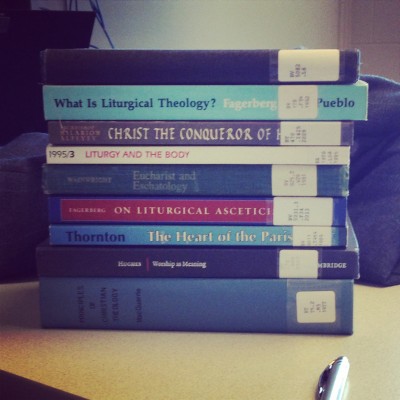Sermon Notes – Easter Sunday – Year B
He Is Risen
Thesis
Choices abound on this blessed morning. Preachers can choose between 3 Collects 7 lessons. It’s a good Sunday when the only lesson without a choice is the Psalm! The most important thing to remember in the midst of all the decision-making is the reality that has changed history: He is risen!!
I am putting these lessons together as if I were to be preaching on Easter Sunday. I may offer a passing comment randomly about the other lessons but basically I am going to cut 3 and 7 down to 1 and 4.
Analysis
Collect
My desire would be to use the second option because it is the Collect that goes with Easter Vigil. It reminds us that an Easter faith is one maintained and strengthened through the Baptismal covenant. However, as not all churches have a Vigil but all will celebrate Easter, I would select the first option because I like its cadence better. Honestly, the first and third options have the same message: Christ has died, Christ is risen, he is victorious, and we are called to die in him and find life in him. Simple message but that’s the point. Easter is simple: he who was dead is no longer dead; he is among the living! The ramifications of the Resurrection are also simple: victory, new creation, salvation, and the call to discipleship.
First Reading
I would include Isaiah 25:6-9 as my first reading. It reads like the eschatological vision of the heavenly city in Revelation. Death has been swallowed up. There are no more tears. The LORD has saved his people and is all in all. Isaiah gives an eschatological vision that is echoed by Jesus, the New Testament writers, and John. It is a vision of the eschatological banquet table that has been set up by YHWH. The table is heavy-laden with rich food and drinks. Who is present? All peoples! Who presides? The LORD!
This has been accomplished through death. The idea of a mountain should immediately bring a plethora of biblical images to mind: Mt. Moriah with Abraham and Isaac, Mt. Carmel with Elijah, Mt. Sinai with Moses, Mt. Tabor with the Transfiguration, and Jerusalem as the City on a Hill. God has been relating to this people through mountain-top experiences and this mountain-top experience will literally change the course and meaning of human history.
God will finally be all in all for his people. He has always been all in all but they (read: we) didn’t know it. He will be their God and they will be his people. His shalom will be known throughout all the earth. Only the victory of Almighty God will be known and it will be celebrated. This passage preaches itself.
Psalm
As I mentioned above, there are no options for the Psalm. This is a song of exultation (v. 15) because the Lord has acted (v. 24)! He has acted through the cornerstone once rejected (v. 22) and won for his people salvation (v. 14 and 21). The Lord is the one who has accomplished this (v. 23).
Written in a format similar to the great songs of the Bible: Moses, Miriam, Hannah, Zechariah, Mary, etc. this Psalm is to be read with great joy and passion on Easter morning. God has acted definitively and decisively on behalf of his people. His actions have opened the gates of righteousness (see Collect #3). This is a song of victory, of thanks, and of joy.
There is a response from the one who enters through the gates: thanksgiving. Entrance is not merely enough. Think of Jesus’ parable about the wedding banquet and garment. It was not enough for the man to attend the party. No, he needed to have on the right garment and participate. It is also not enough for us to “walk through the gate” only to remain the same. We are called to respond and that response is thanksgiving—it is eucharisteo.
Second Reading
Now I would select Acts 10:34-43 because it has more of a creedal dimension to it than the passage from 1 Corinthians 15. Actually, the passage from 1 Corinthians 15 that I would have included would have been later in the same chapter when Paul remarks on the necessity of the resurrection because without it we are to be pitied more than all men. Moving right along…
Peter is in the house of Cornelius and has received his vision of the sheet, the animals, and God’s voice telling him to kill and eat. That is, Peter is realizing that in the Kingdom of God all are invited and the world has been changed. He is now relating to Cornelius’ household that which has taken place in Jesus. Peter is speaking to gentiles. This is massive! The gospel of Jesus Christ is now beginning as a grassroots effort and it will one day make its way to Rome and then the ends of the earth. Peter is putting into practice that which he has learned from his heavenly vision just verses before. This is the work with which the Lord commissioned his disciples: Judea, Samaria, and the ends of the earth!
Even in the English translation there is a good cadence to this passage; Peter’s words are expertly chosen and none are out of place. It is very creedal. Remember that the books of the Bible were written many years after these events took place; my point is that Peter’s homily on the action and work of Jesus is part of an oral tradition that has been passed along from the time that Acts 10 took place in real life to the time it was put on paper by Luke. In 1 Corinthians 15 Paul talks about passing along that which he has received (paralambano) and this is such an example.
The story is simple: God sent Jesus, John announced Jesus, Jesus healed and taught, he was put to death, God raised him from the dead, and he appeared to the disciples and others. It is not as poetic as the Apostles’ Creed but it matches the Creed’s simplicity. This is the story to be told over and over and over again; it is the story of victory, of action, and it is a story that literally transforms lives.
Think about what happens to Cornelius’ household after this: they believe and are baptized. The response of belief was followed up by baptism into the covenant and therefore discipleship.
Notice also how Peter makes reference to being a witness. A witness is not merely someone who sees an event—it is much more than an “eye-witness” like we are used to. No, Peter is a witness by testifying and proclaiming the truth. That is how you demonstrate your witness: through action, not vision.
Gospel
This is the toughest choice you’ll face: John’s poetic and powerful version of the resurrection or Mark’s abrupt end. I actually enjoy Mark’s ending as much as I do John, but because John 18-19 was used for Good Friday and is fresher in the minds of the people I would select John 20 for Easter Sunday.
John begins with the phrase “on the first day of the week.” This is a very important concept for Johannine theology and the early church. Joseph Cardinal Ratzinger (Pope Benedict XVI Emeritus) highlights this in The Spirit of the Liturgy. The first Easter has three different yet intertwined meanings: it is the first day, the third day and the eighth day. As the first day it is the day after Sabbath, it is the day of creation. As the third day it is the third day from the Crucifixion. As the eighth day it is the first day of a new week and is therefore the day of new creation. John has been piecing his gospel together in such a way that this day in chapter 20 is both first and eighth day. Baptismal fonts tend to be eight-sided as a reminder that you are being baptized into new creation. Baptism and Easter go hand in hand. File this bit of “Eighth Day theology” away because you’ll want to come back to it throughout your ministry.
Mary is the first to the tomb on this day and she sees the stone is rolled away. She fetches Peter and John who race to the tomb; John is faster! They both go in and see the tomb empty, the linens rolled up and the story says that John (the author) believed. They didn’t understand but he believed.
Meanwhile, Mary is still in the garden. She is weeping. Her Lord has been taken away. Two angels visit her and inquire about her crying and she tells them why. She turns and sees Jesus only she doesn’t see Jesus. Anecdotally, I proposed to Rebecca in Paris and did so by arriving unannounced. Rebecca was completely unaware that I was coming to Paris from Atlanta, GA. I stood against a light pole in Place Vendome and read a newspaper while Rebecca and her family made their way toward me. Rebecca looked up and saw me, only she did’t see me. She looked back down and then did a double take when it registered that I was right in front of her. I was out of place, out of context in Paris and she had no category for that. Mary sees Jesus but this is also out of place, out of context because he is supposed to be dead. Instead he is living, he is standing, he is breathing and he is calling to her. She needs a moment before she can realize what is happening.
I love what John does her: Mary thinks Jesus is the gardener. But isn’t he? I mean, the original vision in the Garden of Eden was for Adam and Eve to be the stewards of all creation and to care for the garden. Jesus is the Second Adam, the New Adam so isn’t it fitting that he is mistaken for being a gardener? He IS the gardener!
Jesus calls Mary by name and that is how he is revealed. She knows that voice, she knows that name, she knows the one who is speaking to her and so she turns to embrace him. Oh that we would embrace our Lord like that! Jesus commissions Mary to be the first bearer of Good News and to announce to his followers that he is alive.
Let’s think once more about being a witness. In 1st century Jerusalem it was unthinkable for a woman to be a witness. (If you believe any of the early beliefs that Mary was a harlot—and I am not endorsing those here—then you would have a doubly unfit witness). Jesus reveals himself as Risen Lord first to a woman and has her go and spread the news. The Good News of Jesus is ushered forth from Gethsemane by the wrong person because God’s kingdom is full of all the wrong people. What does she announce? “I have seen the Lord.” It is always simple with John. “Come and see.” “We would see Jesus.” “I have seen the Lord.” And yet, and yet, isn’t that just perfect: our rationalizations and mental constructions of evangelism and controlling the Spirit are nothing compared to the simplicity of Jesus’ call.
Liturgical Considerations
The principal service of Easter is at it’s absolute best when it is celebrated in conjunction with the great Easter Vigil on Saturday night. Look at the second collect; it references “this holy night” which only makes sense when you are saying/hearing that prayer during Vigil. It is one of the few Collects that takes anamnesis seriously and suggests that this holy night is actually the holy night. I a sense it transports believers to the Upper Room with the disciples who are in mourning and waiting only to be greeted by the Risen One.
The beauty of following the Light of Christ (Paschal Candle) into the sanctuary, of hearing the Exultet, of reading 10 lessons covering the salvation history of the Old Testament and in welcoming others into the baptismal covenant—meanwhile reaffirming your own faith—places a particular meaning on Easter that is lost without keeping Vigil. I’m sure it is far too late to consider keeping a Vigil this year but I would encourage you to do two things immediately: 1) set up a meeting with your worship arts team (or whomever is responsible for liturgical services in your church) during Eastertide and begin planning for Vigil 2016. 2) Find a local church that is offering a Vigil this year and join them. The historicity and beauty of this service is wonderful. Church of the Resurrection in Wheaton, Ill has a Vigil that is top-notch.
Don’t forget about those “Alleluias”! You have hopefully hidden the “alleluias” (unless your Orthodox) for all of Lent and are finally able to use them in their proper context: greeting our Risen and Living Lord.
Synthesis
What does all of this mean? It means that Jesus is risen from the dead! He has trampled down death by death and has returned to his followers; he does not return as a ghost but as the Risen Lord with a glorified body.
Resurrection was a widely held belief by Jews of the day but no one anticipated a resurrection before the Resurrection on the Last Day. Peter, John, Mary, etc. had no category for the beginning of new creation as seen in Jesus. But John believed and Mary announced.
The first day is the third day is the eighth day and it is the day on which Jesus begins putting the world to rights. New creation is being ushered in one bit at a time, awaiting the return of the King that all may be made new. This is the work to which you have been called: to witness, to announce, and to embody.
Peter witnessed the events of Jesus first hand and shared them with Cornelius’ household and countless others. Mary was the first to embrace the Risen Lord and she was sent away with a mission: to announce his resurrection. Are you about the work of building for God’s kingdom? Are you looking forward to the eschatological banquet by making Jesus known in the present? Remember, Easter and baptism go hand in hand. Baptism is not a silver spoon, it is an invitation into the very life of the triune God and it is an invitation to radical discipleship. Will you answer? Will you follow? Will you announce?











